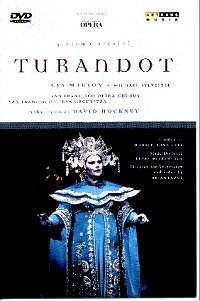Inevitably, criticism
of DVDs, of operas, must concentrate
on the visuals. In this case, David
Hockney's designs score highly. Thankfully
he has opted for a basically traditional
approach and the results are very pleasing
and highly dramatic.
Act I opens on a scene
in stark reds and blues - only primary
colours for this lurid, barbaric scene,
no subtle shades of colour here! The
buildings that comprise the Imperial
Palace are huge, black and threateningly
distorted in their perspectives, echoing
Puccini's slashing discordant notes
that open the opera, seizing our attention
and making us realise that he is to
use the orchestra in a fresh way. The
lighting is highly dramatic, too, with
the faces of the crowd lit red as they
thirst for blood after the mandarin's
proclamation. Only Calaf, Timur and
Liù are bathed in the cooler
blue light of reason. This blue, turned
ghostly, predominates as the crowd exhorts,
to the moon, 'O severed head' singing
to almost Debussy-like soft impressionistic
music that completely belies the barbarity
of the words. This chorus by the way
is excellent and is one of the highlights
of the San Francisco Act I. The lantern-lit
procession of the doomed Prince of Persia
is a nice bit of theatre especially
when the Prince is shown the huge sword
that will severe his head. It casts
a gigantic shadow on an upper casement
which will open to reveal Turandot,
clothed in red, who, ignoring the pleas
of mercy from the crowd, signals that
the young Prince be executed. The well-known
arias towards the end of the Act please.
Liù (Lucia Mazzaria) after a
bit of a waivery start, poignantly tries
to dissuade Calaf from rashly accepting
Turandot's challenge. But, of course,
Michael Silvester, all rash bravado,
and a stout Calaf, in many senses of
the word, rushes forward to bang the
gong to accept the challenge. This closing
spectacle should have had more dramatic
impact - it is certainly one of the
most powerful in the Puccini canon except,
perhaps, for the closing of Act I of
Tosca.
Ping, Pang and Pong's
pavillion which is the set for Scene
One of Act II is the warmest and most
intimate, for these loveable commedia
dell'arte characters. Hockney's design
has flattened furniture in a false perspective
backdrop plus a beautiful monochrome
tapestry hanging down like a huge oblong
pennant. This has a watery picture of
pagodas and willows but when the trio
sing nostalgically of their homes this
picture softens and becomes dreamily
nocturnal in the semi-darkened room.
This lovely evocative little number
is sung beguilingly by Ping, Pang and
Pong who, by the way, are excellent
as both actors and singers. Scene Two
returns us to another aspect of the
outside of the palace, but again shown
as huge and domineering with the Emperor
enthroned at the top of a huge staircase
spiralling downwards towards the front
of the stage. This time the setting
has the advantage of daylight and we
can appreciate all the lavish costumes
resplendent in crimsons, yellows blues
and golds. Turandot (a magnificently
regal and haughty Eva Marton) appears
in green to set Calaf those fateful
riddles. She radiates chilly contempt
but as Puccini's passionate Mai nessun
m'avrà (none shall posses me)
music reaches its climax, before the
setting of the three riddles, its sudden
romantic sweetness suggests Calaf's
triumph and Turandot's eventual melting
and surrender. Sylvester is fierily,
confidently heroic as he wins his way
through the riddles and throws down
his own challenge to Turandot to discover
his name.
The nocturnal stage
setting for Act III has sylvan beauty.
Silhouettes of tree boughs frame a bridge
as figures cross an indigo background
bemoaning that none can sleep for the
identity of the stranger must be discovered.
The dark colours are broken by one solitary
full moon-shaped red lantern passing
to and fro in the background. This is
a very atmospheric introduction to the
hit number of the opera Nessun dorma!,
delivered to rapturous applause by an
ardent Sylvester. Later we are treated
to a much more confident Liù,
affectingly poignant as she prophesies
that Turandot will learn to love Calaph,
too, as she sacrifices her life to keep
his identity secret. Kevin Langan as
Timur impresses too (as he had done
in Act I). He has an oaken authority
yet a touching venerable vulnerability
as well. The final sequence in which
the steeliness of Turandot's resolve
is at last broken by Calaf's passion,
and the warmth of his kiss, is stage
managed well - as is the celebratory
ending as Turandot declares the name
of the stranger to be Love.
Runnicles brings out
all the barbarity, passion, romance,
and comedy in Puccini's score together
with all its exotic orientalisms that
are so much more subtly integrated into
the score than they were in Madama
Butterfly. [Contrary to the denigrations
of so many unsympathetic or misinformed
critics, Puccini was still experimenting
in Turandot, and one wonders
how much more he might have achieved
if he had lived longer.]
One grouse and one
that has been aired on this site before
in connection with ArtHaus Musik's DVDs.
We need more detailed mid-act, mid-scene
links from the menus please. It's fine
having just the Acts and Scenes as separate
cues on a first viewing, but afterwards
viewers will, more often than not, want
to access specific arias. Audio CDs
have such access facilities - why can't
these DVDs?
Ian Lace
